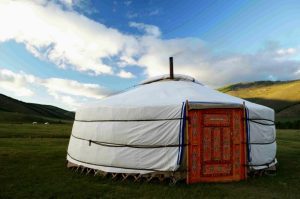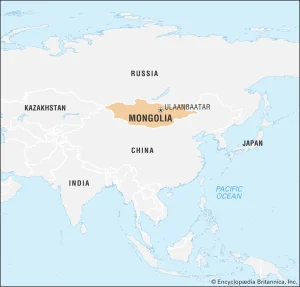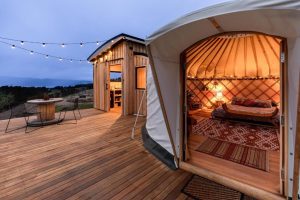What is a Yurt?
A yurt is a portable, circular dwelling made of a wooden lattice framework covered with fabric or skins, topped with a conical roof. Yurts are similar to tents; however, much sturdier and roomier, as they contain some of the strongest shapes in mathematics. Their circular base helps resist wind from any direction, while the lattice walls are composed of interconnected triangles, known for their structural strength, which lead into a well-supported conical roof. Though still widely used in modern-day Mongolia, yurts have also become a popular part of the glamping ecosystem for their sustainability, eco-friendliness, and unique charm.
What is the History of the Yurt?

Yurts originate from Central Asia, particularly Mongolia, and have been used for thousands of years. The Buryat Mongolian community of Siberia claim to have originated the ger, the Mongolian term for yurt. The earliest recorded pictorial evidence of yurts dates back to 600 BCE, found in the Zagros Mountains of Iran, while the first written description was by Greek historian Herodotus in 440 BCE, describing the dwellings of the Scythians, a nomadic tribe in Iran.
Genghis Khan famously ruled his empire from a large yurt. During the height of the Mongolian Empire, yurts spread west into regions such as Turkey, Hungary, and Romania, and they remained common in Turkey well into the 1960s and 1970s.
Today, yurts are still an integral part of Mongolian life. Approximately 61% of Ulaanbaatar’s population lives in gers. City officials have designated “yurt quarters,” which function more like close-knit communities than typical city blocks, often sharing spaces and amenities.
Yurts are also popular in Turkmenistan, Uzbekistan, Kazakhstan, and Kyrgyzstan. Notably, the national flag of Kyrgyzstan features a yurt crown at its center, and the coat of arms of Kazakhstan is built around the same motif.
What Does the Word “Yurt” Mean?

The word yurt comes from the Proto-Turkic language and means “dwelling place.” In Mongolian, the term is ger, which translates to “home” or “house.” While each culture has its own name for the structure, they all roughly translate to the same idea: home, homeland, or kin.
How are Yurts Built?
Often considered a low-cost tiny house alternative, the Mongolian yurt is remarkably efficient.
Yurts can be set up or taken down in as little as 30 minutes to a few hours, and are typically used by groups of 5 to 15 people.
Traditional yurts feature a collapsible wooden lattice frame called a khana, covered with wool felt. Today’s modern yurts may use synthetic materials like tarps or canvas instead of wool. The frame includes a door frame for hanging a wooden door, and the lattice is typically made from flexible woods such as bamboo, birch, willow, or poplar. The size is often described by the number of walls or panels, for example, a 5-wall or 7-wall yurt.
The roof is the most complex part. At its center is the crown (toono), to which roof poles (uni) are attached. Two decorative upright posts (bagana) can be added to support the crown, prevalent for larger yurts. The crown is often partially open to allow air circulation.
Yurts are typically heated with a central stove, fueled by wood, propane, or electricity. Wood is traditionally used, as it provides a warm, dry heat. A chimney extends from the stove through the roof. Over time, smoke stains on the fabric can help waterproof the yurt and serve as a symbol of its age; however, modern yurts often include house wraps to provide extra insulation and moisture protection.
How Did Yurts Get Introduced to the West?

In the 1960s, William Coperthwaite introduced yurts to the U.S. after reading a 1962 National Geographic article about Mongolia. At the time, he was teaching math at a Quaker school in New Hampshire and was intrigued by the geometric engineering of the yurt roof. Shortly after, his class built what became the first yurt in the Western world.
In 1978, Pacific Yurts became the first American company to manufacture yurts using architectural fabrics and structural engineering. Today, at least 17 U.S. states incorporate yurt camping into their park systems.
Since then, yurts have become part of the sustainable living movement for their efficiency and low carbon footprint. Modern yurts push the design far beyond the traditional style of a yurt, including energy-saving upgrades, such as high-efficiency curved glass windows, clear vinyl skylights, and sailcloth or polyester coverings.
What Amenities Do Yurts Come With?

Yurts generally come equipped with a sleeping area, such as a mattress or bed, basic furniture, and heating via a stove or electric heater. While most require you to bring your own sleeping bags, pillows, and linens, some offer fully furnished accommodations. More luxurious yurts may include private bathrooms with showers and toilets, as well as kitchenettes with appliances like mini-fridges, microwaves, and coffee makers.
Yurts offer more space and comfort than traditional tents and serve as a great basecamp for glampers and campers alike. They allow travelers to pack lighter, as many amenities are already on-site. Yurt camping provides a culturally rich experience, offering a taste of traditional Mongolian life without needing to travel across the world. At the higher end, luxury yurts rival the comfort of boutique hotel rooms.



